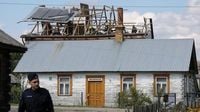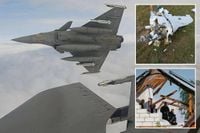Last week, the war in Ukraine took a dramatic turn as Russian drones, intended for Ukrainian targets, veered into Polish airspace, provoking a swift and unprecedented response from NATO. For the first time in the alliance’s 75-year history, NATO fighter jets engaged enemy targets within allied airspace, marking a new and dangerous escalation in the conflict—and thrusting the debate over a no-fly zone back onto the international stage.
On September 10, 2025, more than a dozen Russian drones crossed into Poland, a NATO member state, as part of a larger barrage aimed at Ukraine. According to the New York Times, Dutch F-35s scrambled to intercept several of the drones, with reports from WELT indicating that five were on a direct path toward a NATO base before being shot down. The Polish government quickly invoked NATO’s Article 4, which calls for consultations when a member state feels threatened—something not seen since the early days of Russia’s full-scale invasion of Ukraine in 2022.
Poland’s Prime Minister Donald Tusk left no room for ambiguity, stating, “We would also wish that the drone attack on Poland was a mistake. But it wasn’t. And we know it.” Polish Foreign Minister Radosław Sikorski reinforced this stance, declaring, “No, that wasn’t a mistake,” as reported by Politico. German Defense Minister Boris Pistorius echoed these sentiments, arguing that the incursion was a deliberate act by Moscow to test NATO’s resolve.
The drone crisis didn’t stop at Poland’s borders. Romania, another NATO member, scrambled its own F-16 fighter jets days later after detecting a Russian drone in its airspace. The Romanian Defense Ministry reported that the jets tracked the drone until it disappeared from radar, underscoring the growing regional threat posed by Russia’s expanding drone campaign.
For ordinary citizens, the danger became all too real. In the Polish village of Wyryki, near the border with Ukraine, a retiree and his wife were watching live news coverage of the incursion when one of the drones crashed into their home, according to AFP. Meanwhile, Poland’s interior ministry revealed that a total of 16 drones were found throughout the country following the incident.
Ukrainian President Volodymyr Zelenskyy described the drone incursions as “an obvious expansion of the war by Russia,” urging the West to impose additional sanctions. The sentiment was widely shared among European leaders, who viewed the incident as one of the most serious violations of NATO sovereignty to date. As Politico reported, the episode was widely perceived as a military and political test by Russian President Vladimir Putin.
In response, NATO allies acted quickly. Not only did Polish and Dutch fighter jets intercept the drones, but Italian, German, and multinational NATO forces also provided assistance. The alliance announced the launch of Operation Eastern Sentry, a multi-domain mission to reinforce defenses along NATO’s eastern flank. The United Kingdom announced on September 15 that its Royal Air Force would join the operation, with the UK Ministry of Defense stating, “The UK’s commitment to helping NATO defend every inch of allied territory is unshakeable.”
The incursion has reignited the debate over establishing a no-fly zone over Ukraine. Poland’s Foreign Minister Sikorski, speaking to Germany’s Frankfurter Allgemeine Zeitung, called on NATO and the European Union to consider imposing a no-fly zone, at least to intercept drones before they enter allied airspace. “We as NATO and the EU could be capable of doing this, but it is not a decision that Poland can make alone; it can only be made with its allies,” Sikorski said. He added, “Protection for our population—for example, from falling debris—would naturally be greater if we could combat drones and other flying objects beyond our national territory. If Ukraine were to ask us to shoot them down over its territory, that would be advantageous for us. If you ask me personally, we should consider it.”
This is not the first time a no-fly zone has been discussed. President Zelenskyy originally pitched the idea in the early days of Russia’s invasion in 2022, warning Congress that Ukraine lacked the air defenses to repel Moscow’s attacks. However, Western leaders, including then-President Joe Biden and UK Defense Secretary Ben Wallace, rejected the proposal, fearing that direct confrontation with Russian aircraft could spark an all-out war across Europe. Wallace cautioned that such a move would “likely trigger a Europe-wide conflict with a nuclear-armed power.”
Now, with Russian drones repeatedly violating NATO airspace, the conversation has shifted. Sikorski’s current proposal focuses specifically on drones approaching NATO territory, rather than a blanket ban over all Ukrainian skies. The idea is to intercept threats before they cross the border, reducing the risk of debris falling on populations in Poland, Romania, and other neighboring countries.
Moscow’s response has been predictably hostile. The Russian Defense Ministry insisted that “no targets on the territory of Poland were planned for destruction,” claiming that the drones used in Ukraine have a maximum range of 700 kilometers. Former Russian President Dmitry Medvedev warned on Telegram that a NATO-enforced no-fly zone would amount to starting a war with Russia. Kremlin spokesman Dmitry Peskov added that the West’s military support for Ukraine already shows NATO is “effectively engaged in the conflict.”
Amid these tensions, former U.S. President Donald Trump’s reaction was initially muted. “What’s with Russia violating Poland’s airspace with drones? Here we go!” he posted on Truth Social. Days later, Trump sent a letter to NATO nations threatening further sanctions on Russia, but only if alliance members agreed to “STOP BUYING OIL FROM RUSSIA.” He dismissed the conflict as “Biden’s and Zelenskyy’s WAR,” reiterating his position that no U.S. forces would be sent to Ukraine.
Meanwhile, NATO’s Operation Eastern Sentry is underway, with fighter jets and air defenses from multiple countries on heightened alert. The alliance faces a delicate balancing act: deterring further Russian provocations without escalating the conflict into a broader war. For now, the proposal for a NATO-administered no-fly zone remains just that—a proposal. But as drone strikes continue to cross borders and rattle nerves across Eastern Europe, the question of how far NATO is willing to go to defend its members, and the civilians living in their shadow, remains very much open.
As the dust settles over Poland and Romania, the world watches closely. The next move—by NATO, Russia, or Ukraine—could redefine the boundaries of this already volatile conflict.





